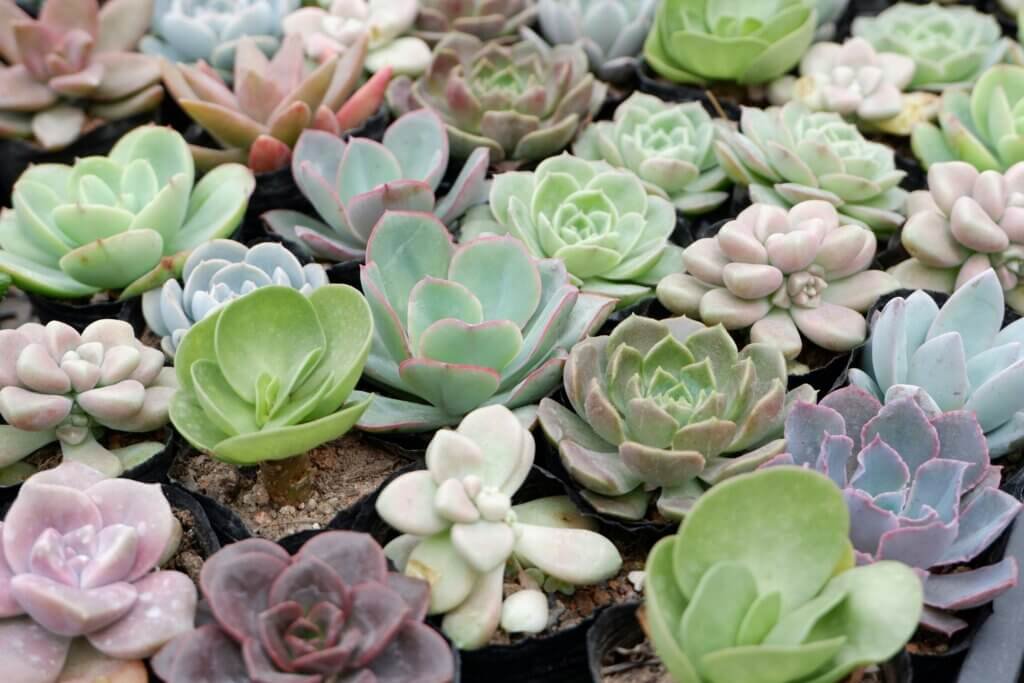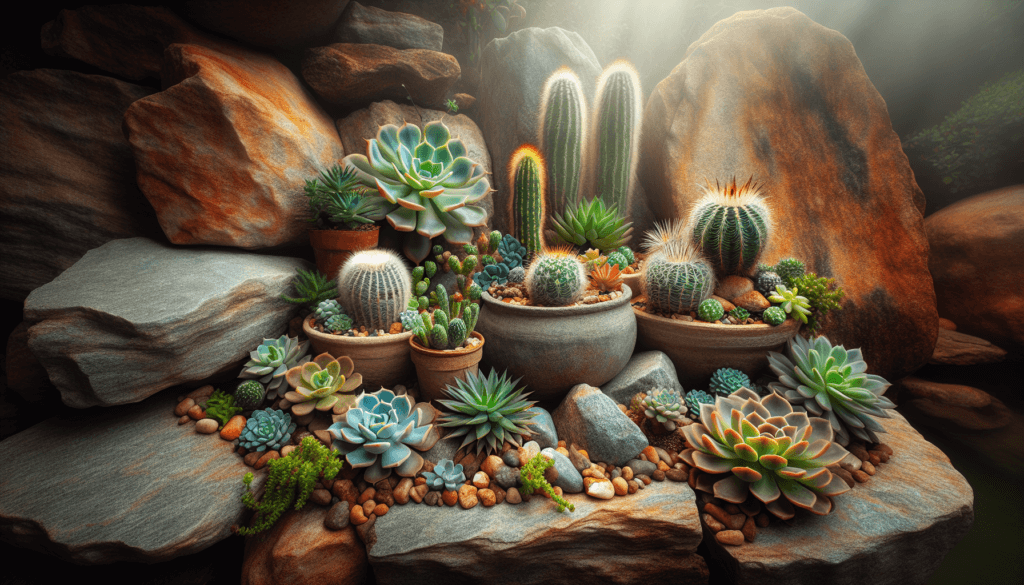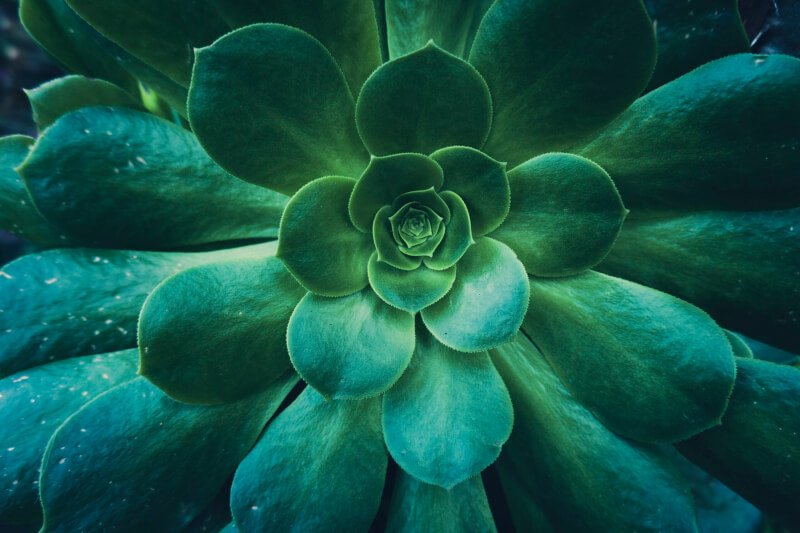If you have a green thumb and love getting your hands dirty, then creating a succulent rock garden might just be the perfect DIY project for you. This article explores the most popular and exciting projects that will transform your outdoor space into a vibrant oasis. From crafting unique container gardens to designing stunning rock arrangements, we will guide you through step-by-step instructions and offer helpful tips along the way. Get ready to unleash your creativity and bring a touch of nature to your home with these captivating DIY ideas.

Choosing the Right Location
Determining the Best Sunlight Exposure
When choosing the location for your succulent rock garden, it is crucial to consider the amount of sunlight it will receive. Most succulents thrive in full sun or bright, indirect light. Observe the area throughout the day and determine how many hours of direct sunlight it receives. Aim for at least six hours of sunlight for optimal growth and coloration of your succulents.
Considering Drainage and Soil Quality
Another important factor to consider when choosing the location for your succulent rock garden is the drainage and soil quality. Succulents, being desert plants, require well-draining soil to prevent root rot and other issues. Before deciding on a spot, evaluate the soil’s drainage by observing how quickly water soaks into the ground. Additionally, ensure that the soil is not overly compacted and has good fertility to provide adequate nutrients for your succulents.
Preparing the Ground
Clearing the Area
Once you have determined the location, it is time to prepare the ground for your succulent rock garden. Begin by clearing the area of any existing vegetation, such as weeds and grass. Removing them will prevent competition for nutrients and ensure that your succulents have the best chance to thrive.
Removing Weeds and Grass
After clearing the area, thoroughly remove any remaining weeds and grass. This step is crucial to prevent them from reestablishing and negatively impacting the growth of your succulents. Use a garden hoe, shovel, or hand-pulling to effectively remove these unwanted plants.
Leveling the Surface
To create an even and visually appealing succulent rock garden, it is important to level the surface. Use a garden rake or leveling tool to ensure that the ground is flat and free of any large bumps or depressions. A well-leveled surface will provide a solid foundation for the rocks and succulents to be arranged.

Selecting the Perfect Rocks
Choosing the Right Size Rock
When selecting rocks for your succulent rock garden, consider the size and scale of your space. Larger rocks can create a dramatic and bold statement, while smaller rocks can contribute to a more delicate and intricate design. Aim to choose rocks that are proportionate to the overall size of your garden and that provide an aesthetic balance.
Considering Color and Texture
Alongside the size of the rocks, consider their color and texture. Rocks come in various shades, ranging from grays and browns to vibrant reds and greens. Take into account the existing color palette of your garden and choose rocks that will complement or contrast beautifully. Additionally, consider the texture of the rocks, as some succulents may benefit from being planted against rough, textured surfaces.
Collecting Rocks from Natural Sources
One option for obtaining rocks is to collect them from natural sources such as local quarries, riverbeds, or hiking trails. This method not only provides a cost-effective solution but also allows you to select rocks that are unique to your geographical area. Remember to obtain any necessary permits and ensure that collecting rocks from natural sources is legal in your location.
Purchasing Rocks from a Store
If natural sources are not readily available or you prefer a specific look, purchasing rocks from a store is a convenient option. Garden centers and landscaping suppliers often offer a wide range of rocks in various sizes, colors, and textures. This allows you to handpick rocks that align with your vision for the succulent rock garden.
Designing the Layout
Planning the Shape of the Garden
Before placing any rocks or succulents, it is essential to plan the shape of your succulent rock garden. Consider the available space, the overall aesthetic you wish to achieve, and the natural contours of your garden. Common shapes for succulent rock gardens include rectangular, circular, or irregular layouts that mimic a natural landscape. Sketching your ideas on paper can help bring clarity to your design.
Creating a Focal Point
To make your succulent rock garden visually engaging, consider creating a focal point. This can be achieved by placing a larger rock or a unique centerpiece plant that draws attention and serves as a focal point. Positioning this element strategically will add depth and interest to your garden.
Arranging Rocks in a Naturalistic Manner
When arranging the rocks in your succulent rock garden, aim for a naturalistic and organic layout. Mimic the way rocks are found in nature, with some partially buried and others protruding at various angles. This will create a more realistic and aesthetically pleasing rock formation. Experiment with different arrangements before settling on the final layout.

Preparing the Soil Mix
Selecting the Appropriate Soil Components
Succulents require well-draining soil with good fertility. When preparing the soil mix for your succulent rock garden, select components that fulfill these criteria. A suitable mixture often includes a combination of porous materials such as coarse sand, perlite, and pumice to enhance drainage. Additionally, incorporate organic matter such as compost or coconut coir to provide nutrients.
Mixing the Soil in the Right Proportions
To ensure a balanced soil mix, it is crucial to mix the components in the right proportions. Aim for a ratio of around 50% porous materials and 50% organic matter. This will create a soil mix that promotes healthy root growth and allows excess water to drain freely. Thoroughly mix all the components before filling the garden beds.
Choosing the Right Succulents
Researching Suitable Succulent Varieties
When selecting the succulents for your rock garden, research suitable varieties that thrive in your climate and specific growing conditions. Consider factors such as temperature extremes, sunlight exposure, and soil moisture levels. There is a wide range of succulent options available, each with its own unique characteristics and growth requirements.
Considering Size and Growth Habit
Take into account the mature size and growth habit of the succulents you choose. Some succulents, like Agave and Aloe, can grow quite large, while others, such as Sedum and Echeveria, remain compact and low-growing. Plan the placement of your succulents accordingly, considering their growth patterns and allowing ample space for each plant to thrive.
Selecting Complementary Colors and Textures
Just as with the rocks, consider the colors and textures of the succulents when choosing which varieties to include in your rock garden. Succulents come in a wide array of hues, ranging from vibrant greens and blues to soft pinks and purples. Experiment with combinations that create a visually pleasing and harmonious palette. Additionally, consider the foliage textures of the succulents, as some have smooth leaves, while others may have intricate patterns or distinctive textures.

Planting the Succulents
Digging Holes for the Plants
When it is time to plant the succulents, dig holes in the soil mix that are wide and deep enough to accommodate their root balls. Ensure that the holes are spaced far enough apart to allow for growth and prevent overcrowding. The depth of the holes should be such that the succulents’ root crowns are level with or slightly above the soil surface.
Placing Succulents in the Soil Mix
Gently remove the succulents from their containers and loosen the root balls to promote healthy growth. Place the succulents in the prepared holes, ensuring that the roots are spread out evenly. Fill the gaps around the plants with the prepared soil mix, gently pressing it down to eliminate any air pockets.
Backfilling and Firming the Soil
After placing the succulents in the holes and adding the soil mix, backfill any remaining gaps with the soil mix. Gently firm the soil around the plants to provide stability and eliminate any settling. Avoid compacting the soil excessively, as this can hinder drainage and root growth.
Caring for Your Succulent Rock Garden
Providing Adequate Watering
Watering is a critical aspect of caring for your succulent rock garden. While succulents are known for their ability to tolerate drought, they still require regular watering to thrive. Water deeply, allowing the soil to dry out slightly between watering sessions. Be cautious not to overwater, as this can lead to root rot and other issues. Adjust the watering frequency based on the weather conditions and the moisture needs of the succulents.
Applying Fertilizer and Nutrients
Succulents generally have low nutrient requirements, but periodic fertilization can promote optimal growth and health. Use a balanced, slow-release fertilizer formulated specifically for succulents. Apply it according to the manufacturer’s instructions, typically during the growing season. Take care not to over-fertilize, as excessive nutrients can cause the succulents to become leggy or susceptible to disease.
Monitoring for Pests and Diseases
Regularly inspect your succulent rock garden for signs of pests or diseases. Common pests that may affect succulents include aphids, mealybugs, and scale insects. Treat infestations promptly using appropriate insecticides or natural remedies like neem oil. Additionally, monitor the plants for any signs of fungal infections or other diseases. Remove and dispose of any infected plant material to prevent the spread of disease to healthy succulents.
Pruning and Trimming Succulents
To maintain the desired shape and appearance of your succulent rock garden, periodically prune and trim the succulents. Remove any dead or decaying leaves, stems, or flower stalks. This will not only enhance the overall aesthetics but also improve air circulation and prevent the spread of diseases. Use clean and sharp pruning tools to minimize the risk of injuring the plants.

Creating a DIY Rock Planter
Selecting a Suitable Container
If you prefer a smaller-scale project, creating a DIY rock planter can be an excellent option for displaying your succulents. Choose a container that is slightly larger than the root balls of your chosen succulents. Ensure that the container has drainage holes to prevent waterlogging and root rot. You can use a variety of materials for the container, such as ceramic pots, wooden boxes, or hypertufa troughs.
Designing the Rock Planter Layout
Once you have selected the container, plan the layout for your rock planter. Arrange the rocks in a visually pleasing manner, considering size, color, and texture. Experiment with different configurations until you achieve the desired look. Remember to leave sufficient space for the succulents to be planted without overcrowding.
Preparing and Arranging the Rocks
Before placing the rocks in the planter, wash them thoroughly to remove any dirt or debris. This will help maintain the cleanliness of the succulent’s environment. Once clean, arrange the rocks in the container, ensuring they are stable and secure. Consider adding smaller rocks or pebbles at the bottom for additional drainage.
Planting Succulents in the Planter
After arranging the rocks, it is time to plant the succulents in the DIY rock planter. Follow the same planting steps mentioned earlier, including digging holes, placing the succulents’ root balls, and backfilling with the soil mix. Take care to position the succulents in a way that enhances the overall composition and ensures their long-term growth and development.
Decorating with Accents
Adding Decorative Pebbles and Gravel
To add extra visual interest and create a polished look, consider adding decorative pebbles or gravel to your succulent rock garden. These materials can be spread around the plants or placed strategically to accentuate certain areas. Choose pebbles or gravel that complement the colors of your rocks and succulents, creating a cohesive and aesthetically pleasing display.
Incorporating Driftwood or Seashells
For a more coastal or natural theme, incorporate driftwood or seashells into your succulent rock garden. Driftwood pieces can be nestled among the rocks or used as a stand for showcasing a particular succulent or decorative item. Seashells, on the other hand, can be placed on top of the soil or scattered around the garden to evoke a beachy atmosphere.
Using Garden Ornaments and Miniatures
Garden ornaments and miniatures can add a touch of whimsy and personalization to your succulent rock garden. Consider including small figurines, fairy houses, or tiny animal sculptures that align with your style and preferences. These decorative elements can be placed discreetly among the rocks or nestled between the succulents, adding charm and a sense of playfulness to your garden.
In conclusion, creating a succulent rock garden is a rewarding DIY project that allows you to unleash your creativity while enjoying the beauty of nature. By carefully choosing the location, preparing the ground, selecting the right rocks and succulents, and paying attention to their care, you can create a stunning and low-maintenance garden that will thrive for years to come. With a little time and effort, you can transform your outdoor space into a breathtaking oasis of succulent beauty.


